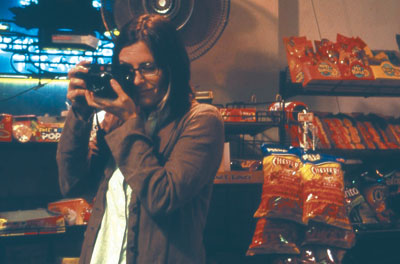LENS CRAFTER
The Mini DV filmmaking revolution has allowed filmmakers to throw away scripts and produce improvisational gabfests, but it’s also inspired directors and d.p.’s to undertake bold experiments in visual style. Greg Harrison set out to change all that with November, an InDigEnt production that won the cinematography prize at Sundance for d.p. Nancy Schreiber. Jason Peterson figures out how they changed the look of Mini DV on a $150,000 budget.
 |
| Courteney Cox in Greg Harrison's November. |
It took a bit of coaxing to convince veteran cinematographer Nancy Schreiber to shoot a feature on a $2,800 Mini DV camera, says director Greg Harrison, whose InDigEnt-backed film November won this year’s Sundance Excellence in Cinematography award.
November portrays the grieving process of a photographer named Sophie (played with surprising grit by Courteney Cox) whose boyfriend (James LeGros) has been shot to death in a convenience store robbery. The tragedy has badly shattered her psyche, making her, as they say in literature class, a very unreliable narrator. In a kind of Rashômon of the mind, we witness the same loose cluster of events play out three times, each time with telling, and sometimes wry, variations that ultimately lead Sophie, and us, to apprehend the true reality of events.
Harrison says he knew when he approached Schreiber, a past Sundance Excellence in Cinematography award winner, that he wanted to help audiences navigate the film’s challenging structure by marking its three movements with distinct color casts (blue for Sophie’s denial, orange for her despair and white for her acceptance). He also knew he wanted to push beyond the “immediate, handheld, natural light aesthetic” that Mini DV films have tended to emulate. In short, he wanted each frame of the film to be artistically worthy of its photographer protagonist.
|
To capture the film’s award-winning look on its tiny shooting budget of $150,000, Schreiber would adapt to the Mini DV medium the skills she’d mastered in shooting more lavishly funded commercials, features (including Neal LaBute’s Your Friends & Neighbors) and documentaries (including Barbara Kopple’s The Hamptons). This was a role that didn’t feel so very different from shooting a music video (like one of the hundred or so she’s shot for the likes of Aretha Franklin, Sting and Van Morrison) where budgets are often lean and solutions improvisatory.
She and Harrison agreed on some shooting rules for the production, one of which was to keep effects in camera as much as possible. Both knew the fallacy of the fix-it-in-post mentality (Harrison keenly so as an editor), especially when working with footage as highly compressed as Mini DV. So capturing the color casts called for some old-fashioned stagecraft. To help get the blue of the first movement, Schreiber pumped machine-generated smoke into the locations. She supplemented this effect with lighting gels and the manual white balance and color temperature controls of the two Panasonic AG-DVX100s on which November was shot.
She used the same techniques, minus the smoke, for the orange and white movements, as well as the convenience store scenes, which are rendered in a pallid green that came from white-balancing the camera to the sodium street lamps outside the store.
Another rule was to eschew handheld camera moves, except when, as Schreiber puts it, scenes “got chaotic” (for example, at the convenience store). Both she and Harrison wanted a more locked-down, controlled look, which meant yoking the little cameras to a whole assortment of downsized dollies, tripods, jibs and car mounts.
Schreiber articulates three more rules, perhaps the most guiding of the whole production: “I find that these little cameras look better with lower light levels, almost wide open [apertures] and as long a lens as you can use.” (In fact, she finds these rules apply to all video cameras, no matter how high-end.)
|
Frederick Elmes, one of the film’s Sundance judges and cinematographer to David Lynch, Jim Jarmusch and Ang Lee, says of Schreiber’s use of light: “She lit it and used colors in a way that the camera responded. And I don’t think that’s the kind of thing you do by accident. That’s completely designed.”
So was her use of wide apertures and long lens. Wide apertures kept the depth of field narrow and the look more filmic. And long lenses, says Schreiber — or, in the case of the AG-DVX100, which doesn’t have interchangeable lenses, zoom settings in the telephoto range — helped avoid showcasing the lack of resolving power that’s so evident in video wide shots, even in the high-definition realm. (The film has just a handful of wide shots: a few establishing interiors and exteriors.)
The end result, aided by smart editing (also by Harrison) and the judicious use of After Effects–generated visual effects (Lew Baldwin), is a film that, says Elmes, “pushes the limits [of Mini DV] further than I’ve ever seen it pushed before in a dramatic situation.”
Go to Sidebar: Producing November: The Power of a Brand
VOD CALENDAR


 See the VOD Calendar →
See the VOD Calendar →


